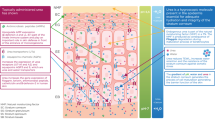Summary
Using a modified sulfide silver method for electron microscopy, the intraepidermal and intracellular localization of epicutaneously applied potassium dichromate was investigated at varying times in sensitized and nonsensitized guinea pigs. The hapten penetrated rapidly into the epidermis. There was a homogeneous extra-and intracellular staining of the keratinocytes in the upper epidermis. The basal and suprabasal cells, by contrast, exhibited a predominant extracellular and plasma membrane localization of the silver grains. This membrane staining pattern was also observed in the Langerhans cells showing cellular and endocytotic activation in the sensitized animals. No specific cellular uptake of the hapten by the Langerhans cells was found. These results demonstrate that the epicutaneous application of chromate resulted in a characteristic intraepidermal distribution which may be related to the epidermal conversion of the hexavalent chromate to the immunogenic trivalent form. Moreover, the absent intracellular localization of the hapten in the activated Langerhans cells supports the notion that contact allergens can be presented to T cells without prior intracellular processing.
Similar content being viewed by others
References
Altrup U, Kolde G (1982) Changes in neuronal arbonizations induced by lesions of the ganglionic perineurium. Neurosci Lett 34:215–220
Brunk U, Skjöld G (1967) The oxidation problem in the sulfide silver method for histochemical demonstration of metal. Acta Histochem 27:199–206
Brunk U, Brun A, Skjöld G (1968) Histochemical demonstration of heavy metals with sulfide-silver method. A methodological study. Acta Histochem 31:345–357
Cronin E (1971) Contact dermatitis. XV. Chromate dermatitis in men. Br J Dermatol 85:95–96
Czernilewski A, Brykoski D, Depczyk D (1965) Experimental investigation on penetration of radioactive chromium (51Cr) through the skin. Dermatologica 131:384–396
Danscher G (1981) Histochemical demonstration of heavy metals. A revised version of the sulphide silver method suitable for both light and electron microscopy. Histochemistry 71:1–16
Danscher G (1982) Exogenous selenium in the brain. A histochemical technique for light and electron microscopical localization of catalytic selenium bonds. Histochemistry 76:281–293
Danscher G, Zimmer J (1978) An improved Timm sulphide silver method for light and electron microscopic localization of heavy metals in biological tissues. Histochemistry 55:27–40
Eisen HN, Tabachnik M (1958) Elicitation of allergic contact dermatitis in the guinea pig. The distribution of bound dinitrobenzene groups within the skin and quantitative determination of the extent of combination of 2,4-dinitrochlorobenzene with epidermal proteins in vivo. J Exp Med 108:773–796
Ernst SA (1972) Transport adenosine triphosphatase cytochemistry. II. Cytochemical localization of ouabain sensitive, potassium dependent phosphatase activity in the secretory epithelium of the avian salt gland. J Histochem Cytochem 20:13–22
Ernst StA, Philpott ChW (1970) Preservation of Na-K-activated and Mg-activated adenosine triphosphatase activities of avian salt gland and teleost gill with formaldehyde as fixative. J Histochem Cytochem 18:251–263
Fregert S (1975) Occupational dermatitis in a 10-year material. Contact Dermatitis 1:96–107
Gurth L, Albers RW (1974) Histochemical demonstration of (Na+−K+)-activated adenosine triphosphatase. J Histochem Cytochem 22:320–332
Jacobsen NO, Jorgensen PL (1969) A quantitative biochemical and histochemical study of the lead method for localization of adenosine triphosphatase hydrolysing enzymes. J Histochem Cytochem 17:443–453
Kolde G, Knop J (1987) Different cellular reaction patterns of epidermal Langerhans cells after application of contact sensitizing, toxic, and tolerogenic compounds. A comparative ultrastructural and morphometric time-course analysis. J Invest Dermatol 89:19–23
Kolde G, Knop J (1988) Ultrastructural localization of 2,4-dinitrophenyl groups in mouse epidermis following skin painting with 2,4-dinitrofluorobenzene and 2,4-dinitrothiocyanatebenze: an immunoelectron microscopical study. J Invest Dermatol 90:320–324
Landsteiner K, Chase MW (1942) Experiments on transfer of cutaneous sensitivity of simple compounds. Proc Soc Exp Biol Med 49:688–690
Mali JWH, Malten K, van Neer FCJ (1966) Allergy to chromium. Arch Dermatol 93:41–44
Mayahara H, Fujimoto K, Ando T, Ogawa K (1980) A new one-step method for the cytochemical localization of ouabain-sensitive, potassium-dependent p-nitrophenyl-phosphatase activity. Histochemistry 67:125–138
Nakagawa S, Ueki H, Tanioku K (1971) The distribution of 2,4-dinitrophenyl groups in guinea pig skin following surface application of 2,4-dinitrochlorobenzene. An immunofluorescent study. J Invest Dermatol 57:269–277
Nishioka K, Funai T, Yokozeki H, Katayama I (1984) Induction of hapten-specific lymphoid cell proliferation by liposome-carrying molecules from haptenated epidermal cells in contact sensitivity. J Invest Dermatol 83:96–100
Oka D, Nakagawa S, Oata T, Ueki H (1986) Distribution of 2,4-dinitrophenyl groups on the epidermal Langerhans cells of guinea pigs following skin painting with 2,4-dinitrochlorobenzene. Dermatologica 172:12–17
Phillips CE (1980) Intracellularly injected cobaltous ions accumulate at synaptic densities. Science 207:1477–1479
Polak L, Turk JL, Frey JR (1973) Studies on contact hypersensitivity to chromium compounds. Prog Allergy 17:145–226
Robinson JM, Karnovsky MJ (1983) Ultrastructural localization of several phosphatases with cerium. J Histochem Cytochem 31:1197–1208
Samitz MH, Katz S (1964) A study of the chemical reactions between chromium and skin. J Invest Dermatol 43:35–43
Samitz MH, Katz SA, Schreiner DM, Gross PR (1969) Chromium-protein interactions. Acta Derm Venereol (Stockh) 49:142–146
Shelley WB, Juhlin L (1977) Selective uptake of contact allergens by the Langerhans cell. Arch Dermatol 113:187–192
Shmunes E, Katz SA, Samitz MH (1973) Chromium-amino acid conjugates as elicitors in chromium sensitized guinea pigs. J Invest Dermatol 60:193–196
Siegenthaler U, Laine A, Polak L (1983) Studies on contact sensitivity to chromium in the guinea pig. The role of the valence in the formation of antigenic determinant. J Invest Dermatol 80:44–47
Snodgrass MJ (1977) Ultrastructural distinction between reticular and collagenous fibers with ammoniacal silver stain. Anat Rec 187:191–205
Timm F (1958) Zur Histochemie der Schwermetalle, das Sulfid-Silber-Verfahren. Dtsch Z Gesamte Gerichtl Med 46:706–711
Walden P, Nagy ZA, Klein J (1985) Induction of regulatory T-lymphocyte responses by liposomes carrying major histocompatibility complex molecules and foreign antigen. Nature (Lond) 315:327–329
Witten VH, Grayson LD, Birnbaum VH (1957) Studies of the mechanism of allergic eczematous contact dermatitis. I. Findings on human skin with radioactive bichloride of mercury. J Invest Dermatol 28:339–348
Zeiger K (1938) Physikochemische Grundlagen der histologischen Methodik. Wiss Forschungsber 48:55–105
Author information
Authors and Affiliations
Rights and permissions
About this article
Cite this article
Saloga, J., Knop, J. & Kolde, G. Ultrastructural cytochemical visualization of chromium in the skin of sensitized guinea pigs. Arch Dermatol Res 280, 214–219 (1988). https://doi.org/10.1007/BF00513960
Received:
Issue Date:
DOI: https://doi.org/10.1007/BF00513960




